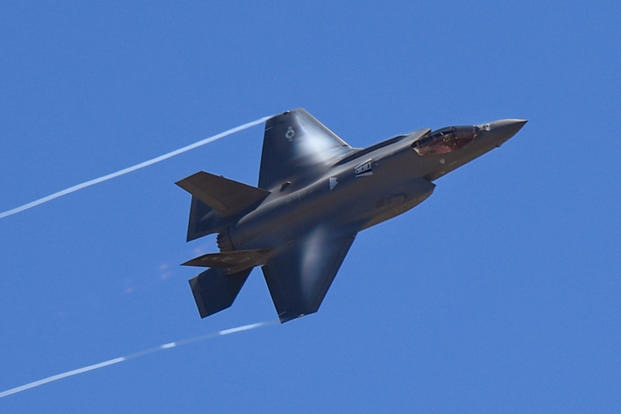The Pentagon is downplaying major F-35 Joint Strike Fighter design flaws that could leave service members at risk in an effort to keep the long-scrutinized program on schedule, a watchdog group warned this week.
A military review board met in June to look at some of the F-35's deficiencies. The group downgraded 19 serious problems without a clear plan to fix them all, according to a new report from the Project on Government Oversight, an independent nonpartisan watchdog that exposes government waste, fraud and abuse.
Before the June meeting, POGO reported, the 19 problems had been labeled Category I deficiencies, meaning they "may cause death, severe injury, or severe occupational illness; may cause loss or major damage to a weapon system; critically restrict the combat readiness capabilities of the using organization; or result in a production line stoppage."
During the meeting, the flaws were switched to Category II deficiencies, a less serious classification that means they "could impede or constrain successful mission accomplishment," according to POGO.
"It was a deliberative process that assigned categorizations for each one of those flaws," Dan Grazier, a veteran Marine officer and military fellow with POGO who wrote the report, told Military.com. "For the program to just make little paperwork changes on these things so they could say, 'Oh look, we've cleared up all of these issues,' is pretty alarming."
The F-35 Joint Program Office hit back, saying the review boards meet regularly to assess deficiencies. Any decisions the program office makes are based on an "established, disciplined and transparent process," said Joe DellaVedova, a spokesman for the office.
"The purpose of the regularly scheduled review board was to assess data-driven categorization, with warfighter input, against the maturity of today's F-35 fleet," he said. "The outcomes are approved by the warfighter and implemented by the F-35 program."
Some of the problems downgraded by the review board from Category I deficiencies to Category II, according to POGO, include:
- A problem with a transponder that doesn't automatically send an emergency signal when a pilot ejects. That means hours could pass before anyone knew a pilot had ejected and crashed.
- A problem with the arresting tailhook on the Air Force variant of the F-35. Test engineers found the aircraft could be damaged when the tailhook was used in the event of brake failure due to a problem called "upswing."
- F-35 pilots firing precision-guided missiles don't currently confirm target coordinates, which could put troops on the ground at risk of being hit by friendly fire.
No specific plans for fixes to these problems were provided during the meeting in which they were downgraded to a less-severe category, according to the report. "This is not how the development process is supposed to work," Grazier wrote.
The F-35's latest Block 3F software has demonstrated the capability and stability to execute all required missions and incorporates all required fixes to identified discrepancies as directed by the warfighter, DellaVedova said. "The program will continue to employ all available resources to deliver combat capability as part of its continuous development methodology."
But Grazier said troops deserve to know more about the process of changing the aircraft's problem categorizations. The Government Accountability Office found in January that the F-35 program had 111 Category I deficiencies. Because the meeting minutes Grazier saw addressed only 19 Category I problems, defense leaders need to explain how they dealt with the other 92, he said.
"I would want to know what else they have treated in this way," he said. "Have [remaining problems] been addressed properly? What else don't we know about this process?"
Mike Friedman, a spokesman for Lockheed Martin, which produces the F-35, said the aircraft continues demonstrating it is the safest and most advanced fighter in the sky. With more than 150,000 flight hours, it has an "exceptional safety record," he said, exceeding any other fighter jet's record at this stage in their maturity.
"Current deficiencies outlined from the F-35 Joint Program Office are known, understood and on a path to resolution, and the latest 3F software has demonstrated the capability and stability to execute all required missions," Friedman said. "While the open items are important to resolve, they represent no imminent impact to safety of flight or key performance parameters. … Lockheed Martin is working closely with the Joint Program Office to prioritize and correct remaining areas to ensure we continue delivering the most advanced aircraft in the world."
Congress needs to continue asking military leaders tough questions about the F-35 program, Grazier said, especially as it's slated to move from a development process into the Initial Operational Test and Evaluation phase next month.
"There are men and women who are going to have to entrust their lives to this aircraft, whether they're flying in them or on the ground being supported by them," Grazier said. "... With all of the money that has been poured into this program, they deserve to have a more complete design."
Editor’s note: This post has been updated to include comments from Lockheed Martin.
-- Military.com's Oriana Pawlyk contributed to this report.
-- Gina Harkins can be reached at gina.harkins@military.com. Follow her on Twitter at @ginaaharkins.










